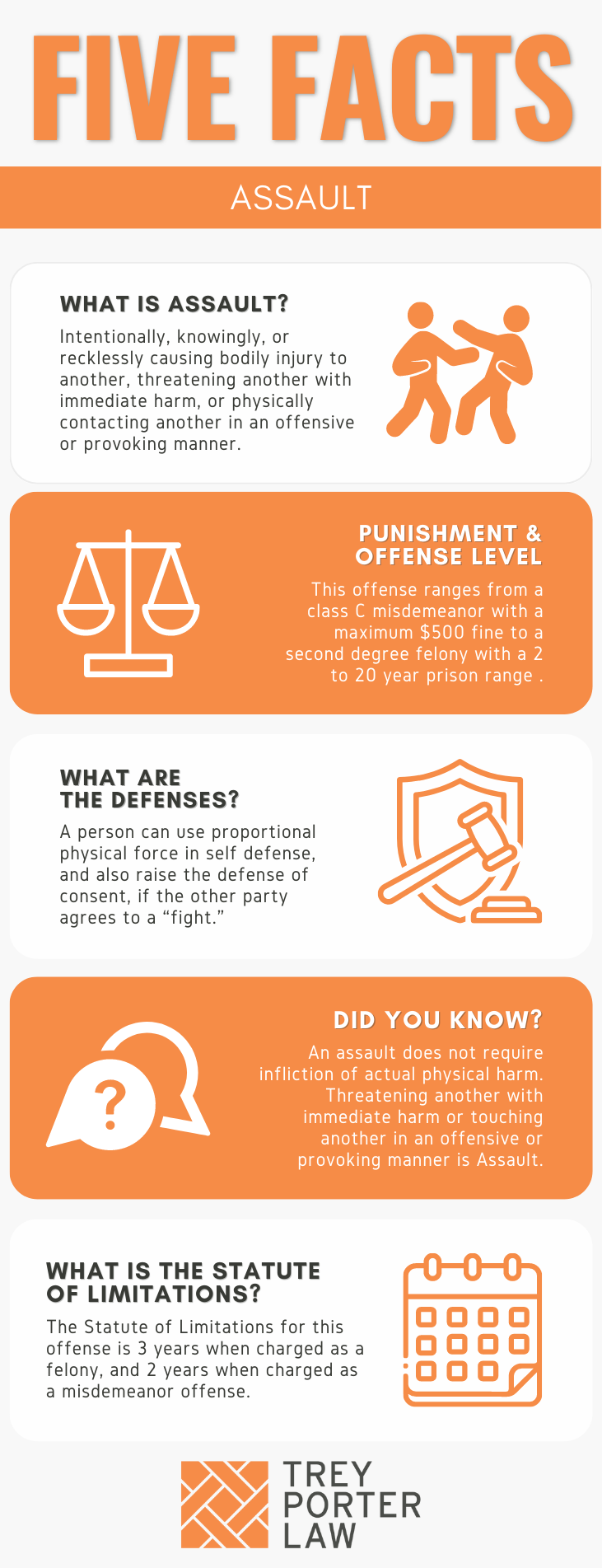WHAT IS ASSAULT IN TEXAS?
The Texas law against assault prohibits intentionally, knowingly, or recklessly causing bodily injury to another person, threatening another with imminent bodily injury, and physically contacting another in a provocative or offensive manner.

Depending on the circumstances, the penalty classification for assault can range from a Class C misdemeanor to a second degree felony.
- What is assault “family violence” or “domestic violence” in Texas? Texas law distinguishes “simple assault” from assault involving family violence, also referred to as assault against a family member, domestic violence, or domestic abuse. Assault is considered family violence if a person intentionally, knowingly, or recklessly causes bodily injury to a family member, roommate or household member, or a current or former significant other. A family violence charge exposes a person to higher penalties and collateral consequences.
- Is assaulting a former significant other’s new partner considered family violence in Texas? Yes. If a person assaults another who is in a relationship with the person’s former spouse or partner, that is considered “dating violence” under the Texas Family Code.
WHAT IS THE ASSAULT LAW IN TEXAS?
Tex. Penal Code § 22.01. ASSAULT.
(a) A person commits an offense if the person:
(1) intentionally, knowingly, or recklessly causes bodily injury to another, including the person’s spouse;
(2) intentionally or knowingly threatens another with imminent bodily injury, including the person’s spouse; or
(3) intentionally or knowingly causes physical contact with another when the person knows or should reasonably believe that the other will regard the contact as offensive or provocative.
(b) An offense under Subsection (a)(1) is a Class A misdemeanor, except that the offense is a felony of the third degree if the offense is committed against:
(1) a person the actor knows is a public servant while the public servant is lawfully discharging an official duty, or in retaliation or on account of an exercise of official power or performance of an official duty as a public servant;
(2) a person whose relationship to or association with the defendant is described by Section 71.0021(b), 71.003, or 71.005, Family Code, if:
(A) it is shown on the trial of the offense that the defendant has been previously convicted of an offense under this chapter, Chapter 19, or Section 20.03, 20.04, 21.11, or 25.11 against a person whose relationship to or association with the defendant is described by Section 71.0021(b), 71.003, or 71.005, Family Code; or
(B) the offense is committed by intentionally, knowingly, or recklessly impeding the normal breathing or circulation of the blood of the person by applying pressure to the person’s throat or neck or by blocking the person’s nose or mouth;
(3) a person who contracts with government to perform a service in a correctional facility, secure correctional facility, or secure detention facility, or an employee of that person:
(A) while the person or employee is engaged in performing a service within the scope of the contract, if the actor knows the person or employee is authorized by government to provide the service; or
(B) in retaliation for or on account of the person’s or employee’s performance of a service within the scope of the contract;
(4) a person the actor knows is a security officer while the officer is performing a duty as a security officer;
(5) a person the actor knows is emergency services personnel while the person is providing emergency services;
(6) a person the actor knows is a process server while the person is performing a duty as a process server;
(7) a pregnant individual to force the individual to have an abortion; or
(8) a person the actor knows is pregnant at the time of the offense.
(b-1) Notwithstanding Subsection (b), an offense under Subsection (a)(1) is a felony of the third degree if the offense is committed:
(1) while the actor is committed to a civil commitment facility; and
(2) against:
(A) an officer or employee of the Texas Civil Commitment Office:
(i) while the officer or employee is lawfully discharging an official duty at a civil commitment facility; or
(ii) in retaliation for or on account of an exercise of official power or performance of an official duty by the officer or employee; or
(B) a person who contracts with the state to perform a service in a civil commitment facility or an employee of that person:
(i) while the person or employee is engaged in performing a service within the scope of the contract, if the actor knows the person or employee is authorized by the state to provide the service; or
(ii) in retaliation for or on account of the person’s or employee’s performance of a service within the scope of the contract.
(b-2) Notwithstanding Subsection (b)(1), an offense under Subsection (a)(1) is a felony of the second degree if the offense is committed against a person the actor knows is a peace officer or judge while the officer or judge is lawfully discharging an official duty or in retaliation or on account of an exercise of official power or performance of an official duty as a peace officer or judge.
(b-3) Notwithstanding Subsection (b)(2), an offense under Subsection (a)(1) is a felony of the second degree if:
(1) the offense is committed against a person whose relationship to or association with the defendant is described by Section 71.0021(b), 71.003, or 71.005, Family Code;
(2) it is shown on the trial of the offense that the defendant has been previously convicted of an offense under this chapter, Chapter 19, or Section 20.03, 20.04, or 21.11 against a person whose relationship to or association with the defendant is described by Section 71.0021(b), 71.003, or 71.005, Family Code; and
(3) the offense is committed by intentionally, knowingly, or recklessly impeding the normal breathing or circulation of the blood of the person by applying pressure to the person’s throat or neck or by blocking the person’s nose or mouth.
(c) An offense under Subsection (a)(2) or (3) is a Class C misdemeanor, except that the offense is:
(1) a Class A misdemeanor if the offense is committed under Subsection (a)(3) against an elderly individual or disabled individual, as those terms are defined by Section 22.04;
(2) a Class B misdemeanor if the offense is committed by a person who is not a sports participant against a person the actor knows is a sports participant either:
(A) while the participant is performing duties or responsibilities in the participant’s capacity as a sports participant; or
(B) in retaliation for or on account of the participant’s performance of a duty or responsibility within the participant’s capacity as a sports participant; or
(3) a Class A misdemeanor if the offense is committed against a pregnant individual to force the individual to have an abortion.
(d) For purposes of Subsection (b), the actor is presumed to have known the person assaulted was a public servant, a security officer, or emergency services personnel if the person was wearing a distinctive uniform or badge indicating the person’s employment as a public servant or status as a security officer or emergency services personnel.
(f) For the purposes of Subsections (b)(2)(A) and (b-3)(2):
(1) a defendant has been previously convicted of an offense listed in those subsections committed against a person whose relationship to or association with the defendant is described by Section 71.0021(b), 71.003, or 71.005, Family Code, if the defendant was adjudged guilty of the offense or entered a plea of guilty or nolo contendere in return for a grant of deferred adjudication, regardless of whether the sentence for the offense was ever imposed or whether the sentence was probated and the defendant was subsequently discharged from community supervision; and
(2) a conviction under the laws of another state for an offense containing elements that are substantially similar to the elements of an offense listed in those subsections is a conviction of the offense listed.
(g) If conduct constituting an offense under this section also constitutes an offense under another section of this code, the actor may be prosecuted under either section or both sections.
Tex. Penal Code § 9.31. SELF-DEFENSE.
(a) Except as provided in Subsection (b), a person is justified in using force against another when and to the degree the actor reasonably believes the force is immediately necessary to protect the actor against the other’s use or attempted use of unlawful force. The actor’s belief that the force was immediately necessary as described by this subsection is presumed to be reasonable if the actor:
(1) knew or had reason to believe that the person against whom the force was used:
(A) unlawfully and with force entered, or was attempting to enter unlawfully and with force, the actor’s occupied habitation, vehicle, or place of business or employment;
(B) unlawfully and with force removed, or was attempting to remove unlawfully and with force, the actor from the actor’s habitation, vehicle, or place of business or employment; or
(C) was committing or attempting to commit aggravated kidnapping, murder, sexual assault, aggravated sexual assault, robbery, or aggravated robbery;
(2) did not provoke the person against whom the force was used; and
(3) was not otherwise engaged in criminal activity, other than a Class C misdemeanor that is a violation of a law or ordinance regulating traffic at the time the force was used.
(b) The use of force against another is not justified:
(1) in response to verbal provocation alone;
(2) to resist an arrest or search that the actor knows is being made by a peace officer, or by a person acting in a peace officer’s presence and at his direction, even though the arrest or search is unlawful, unless the resistance is justified under Subsection (c);
(3) if the actor consented to the exact force used or attempted by the other;
(4) if the actor provoked the other’s use or attempted use of unlawful force, unless:
(A) the actor abandons the encounter, or clearly communicates to the other his intent to do so reasonably believing he cannot safely abandon the encounter; and
(B) the other nevertheless continues or attempts to use unlawful force against the actor; or
(5) if the actor sought an explanation from or discussion with the other person concerning the actor’s differences with the other person while the actor was:
(A) carrying a weapon in violation of Section 46.02; or
(B) possessing or transporting a weapon in violation of Section 46.05.
(c) The use of force to resist an arrest or search is justified:
(1) if, before the actor offers any resistance, the peace officer (or person acting at his direction) uses or attempts to use greater force than necessary to make the arrest or search; and
(2) when and to the degree the actor reasonably believes the force is immediately necessary to protect himself against the peace officer’s (or other person’s) use or attempted use of greater force than necessary.
(d) The use of deadly force is not justified under this subchapter except as provided in Sections 9.32, 9.33, and 9.34.
(e) A person who has a right to be present at the location where the force is used, who has not provoked the person against whom the force is used, and who is not engaged in criminal activity at the time the force is used is not required to retreat before using force as described by this section.
(f) For purposes of Subsection (a), in determining whether an actor described by Subsection (e) reasonably believed that the use of force was necessary, a finder of fact may not consider whether the actor failed to retreat.
Tex. Penal Code § 22.06. CONSENT AS A DEFENSE TO ASSAULTIVE CONDUCT.
(a) The victim’s effective consent or the actor’s reasonable belief that the victim consented to the actor’s conduct is a defense to prosecution under Section 22.01 (Assault), 22.02 (Aggravated Assault), or 22.05 (Deadly Conduct) if:
(1) the conduct did not threaten or inflict serious bodily injury; or
(2) the victim knew the conduct was a risk of:
(A) his occupation;
(B) recognized medical treatment; or
(C) a scientific experiment conducted by recognized methods.
(b) The defense to prosecution provided by Subsection (a) is not available to a defendant who commits an offense described by Subsection (a) as a condition of the defendant’s or the victim’s initiation or continued membership in a criminal street gang.
Tex. Family Code § 71.0021. DATING VIOLENCE
(a) “Dating violence” means an act, other than a defensive measure to protect oneself, by an actor that:
(1) is committed against a victim or applicant for a protective order:
(A) with whom the actor has or has had a dating relationship; or
(B) because of the victim’s or applicant’s marriage to or dating relationship with an individual with whom the actor is or has been in a dating relationship or marriage; and
(2) is intended to result in physical harm, bodily injury, assault, or sexual assault or that is a threat that reasonably places the victim or applicant in fear of imminent physical harm, bodily injury, assault, or sexual assault.
(b) For purposes of this title, “dating relationship” means a relationship between individuals who have or have had a continuing relationship of a romantic or intimate nature. The existence of such a relationship shall be determined based on consideration of:
(1) the length of the relationship;
(2) the nature of the relationship; and
(3) the frequency and type of interaction between the persons involved in the relationship.
(c) A casual acquaintanceship or ordinary fraternization in a business or social context does not constitute a “dating relationship” under Subsection (b).
WHAT IS THE PENALTY CLASS FOR ASSAULT IN TEXAS?
The penalty category for assault depends on the severity of the conduct, whether the accused has been previously convicted of assault, and the victim’s status. Assault is a:
- Class C misdemeanor, punishable by a maximum $500 fine, if the person:
- threatened another with imminent bodily injury; or
- caused physical contact with another and knew or should have known the other person would regard the contact as offensive or provocative;
- Class B misdemeanor, punishable by up to 180 days in county jail, if the person:
- caused offensive or provocative contact with, or threatened imminent bodily injury to, a sports participant either during the sporting event or because of the victim’s status as a sports participant;
- Class A misdemeanor, punishable by up to one year in county jail, if:
- committed by threats of imminent bodily injury, or offensive or provocative contact, and:
- the victim was pregnant, and the person contacted or threatened the victim to force her to have an abortion;
- committed by physically contacting an elderly or disabled person in an offensive or provocative manner;
- committed by intentionally, knowingly, or recklessly causing bodily injury to another;
- committed by threats of imminent bodily injury, or offensive or provocative contact, and:
- Third degree felony, punishable by two to ten years in prison, if the person intentionally, knowingly, or recklessly causes bodily injury to:
- a family or household member, or a person with whom the person has or has had a dating relationship, by impeding the normal breathing or circulation—i.e., by choking, strangulation, or otherwise blocking a person’s nose or mouth, or applying pressure to the throat or neck;
- a family or household member, or a person with whom the person has or has had a dating relationship, and:
- the person has been previously convicted or placed on deferred adjudication for an offense involving family violence—specifically, for committing one of the following crimes against a member of his or her family or household, or person with whom he or she had a dating relationship:
- assault, indecent assault, or aggravated assault;
- sexual assault or aggravated sexual assault;
- indecency with a child;
- injury to a child, elderly individual, or disabled individual;
- deadly conduct;
- terroristic threat;
- murder, capital murder, manslaughter, or criminally negligent homicide;
- kidnapping or aggravated kidnapping;
- continuous violence against the family.
- the person has been previously convicted or placed on deferred adjudication for an offense involving family violence—specifically, for committing one of the following crimes against a member of his or her family or household, or person with whom he or she had a dating relationship:
- a public servant on duty;
- a process server performing his or her duties;
- a security officer acting in his or her official capacity;
- a pregnant woman, regardless of whether the assault is to force her to have an abortion;
- a first responder or emergency services personnel administering emergency services;
- a government contractor performing work in a correctional facility or juvenile detention facility;
- an officer, employee, or state contractor working in a civil commitment facility, while the accused is committed to the civil commitment facility.
- Second degree felony, punishable by two to 20 years in prison, if the person intentionally, knowingly, or recklessly causes bodily injury to:
- a peace officer or judge in retaliation for or on account of their service or status;
- a family or household member, or one with whom the person has or has had a dating relationship, by:
- choking, strangulation, or otherwise impeding the normal breathing or circulation of the blood by applying pressure to the person’s throat or neck or by blocking the person’s nose or mouth; and
- the person has a previous conviction for an offense involving family violence.
WHAT IS THE PUNISHMENT RANGE FOR ASSAULT IN TEXAS?
The punishment range for assault increases depending on the victim’s status, and whether the person has previously been convicted of committing an offense involving family violence.
- Second degree felony (two to 20 years in prison, maximum $10,000 fine):
- assault causing bodily injury against a peace officer or judge; or
- assault by choking or strangulation (“occlusion assault”) against a family or household member, or one with whom the person has or has had a dating relationship, with at least one previous family-violence conviction;
- Third degree felony (two to ten years in prison, maximum fine of $10,000):
- assault causing bodily injury against a:
- public servant, emergency services person, process server, officer or employee of a civil commitment facility, government contractor working in a juvenile detention facility or correctional facility, pregnant woman; or
- the second offense (or more) of assaulting a member of the person’s family or household, or one with whom the person has or has had a dating relationship;
- assault by choking or strangulation against a family or household member, or one with whom the person has or has had a dating relationship—known as “occlusion assault.”
- assault causing bodily injury against a:
- Class A misdemeanor (up to one year in jail, maximum fine of $4,000):
- assault causing bodily injury;
- first offense of assault causing bodily injury to a family or household member, or one with whom the person has or has had a dating relationship;
- physically contacting an elderly or disabled individual in an offensive or provocative manner;
- threatening imminently bodily injury to, or offensively or provocatively contacting, a pregnant person to force her to get an abortion.
- Class B misdemeanor (up to 180 days in jail, maximum fine of $2,000):
- assault by offensive or provocative contact or threats of imminent bodily injury to a sports participant.
- Class C misdemeanor (maximum fine of $500):
- assault by offensive or provocative contact or threats of imminent bodily injury.
Texas law increases the penalty classification for assault to the next highest category, or to minimum confinement of 180 days in jail if the assault is a Class A misdemeanor, if a person commits the offense in an area subject to an emergency evacuation order, or under a declaration of a state of disaster by the governor or president of the United States. See Tex. Penal Code § 12.50.
WHAT ARE THE PENALTIES FOR ASSAULT IN TEXAS?
A person charged with assault may be eligible for probation after a conviction, or deferred adjudication without a conviction. The maximum period of deferred adjudication for a Class C misdemeanor is 180 days. Community supervision for a Class A or Class B misdemeanor may not exceed two years, and may be no more than ten years for second degree and third degree felonies.
- Is deferred adjudication the same as a conviction for enhancing a subsequent family violence offense? Yes, according to Subsection 22.01(f). If a person is placed on deferred adjudication for a Class A misdemeanor assault involving family violence, it may be used to enhance any subsequent family or domestic violence charges to a third degree felony.
- Is an “affirmative finding of family violence” required to enhance a subsequent family violence offense? No. To enhance an assault family violence charge to a third degree felony with a previous conviction or deferred adjudication, the State must prove the accused has been convicted of or placed on deferred adjudication for assaulting a member of his or her family or household, or one with whom the accused had a dating relationship. This may be accomplished by using extrinsic evidence.While the best practice is to offer the judgment of a prior conviction reflecting an affirmative finding of family violence, as required by Article 42.013 of the Texas Code of Criminal Procedure, it is not fatal if the judgment or order of deferred adjudication does not reflect such a finding.
- Does a family violence conviction or deferred adjudication affect a person’s right to own a gun? Yes. Texas Penal Code Section 46.04 prohibits possessing a firearm within five years after a person’s release from jail or community supervision after being convicted of or placed on adjudication for assault family violence. Even an arrest for an offense involving family violence may affect a person’s right to legally own and carry a firearm. See Ex parte Isedore, No. 14-22-00161-CR (Tex. App—Houston [14th Dist.] Jan. 10, 2023, no pet.).Federal law likewise prohibits a person convicted of or placed on deferred adjudication for an offense involving family violence from possessing or owning a gun under federal law. See 18 U.S.C. 922(g).
WHAT ARE THE DEFENSES TO ASSAULT IN TEXAS?
A person charged with assault by causing bodily injury may raise any of the justification defenses at trial, or attempt to negate one of the elements the State must prove beyond a reasonable doubt.
- Is there a “mutual combat” defense to assault? Texas Penal Code Section 22.06 authorizes a person charged with assault to raise the defense of consent, or “mutual combat,” if the victim and accused agreed to fight before the alleged assault occurred. The consent defense does not apply to an assault during a gang initiation.
For the defense of consent to apply, the accused must show:
- the victim, or “complainant,” effectively consented to the accused’s conduct or the accused reasonably believed that the complainant consented to the accused’s conduct; and
- the accused’s conduct did not threaten or inflict serious bodily injury, or
- the complainant knew the conduct was a risk of his occupation, recognized medical treatment, or a scientific experiment conducted by recognized methods.
- What is self-defense? Texas Penal Code Section 9.31 explains a person is justified in using force against another when and to the degree he reasonably believes force is immediately necessary to protect against the other’s use or attempted use of unlawful force.The accused need not prove the victim was actually using force—a person has the right to defend himself from apparent danger as he reasonably apprehends it. A person’s use of force is presumed reasonable if used against another who was:
-
- unlawfully entering or attempting to enter the person’s home, vehicle, or place of business or employment;
- unlawfully removing or attempting to remove the person from his or her home, vehicle, or place of business or employment; or
- committing or attempting to commit aggravated kidnapping, murder, sexual assault, aggravated sexual assault, robbery, or aggravated robbery.
A person may not use force in response to verbal provocation alone, or if the person provoked the victim’s initial use of force.
- What if the accused started the fight prior to assaulting the other person? If the accused “provoked the difficulty,” he or she forfeits any claim of self-defense. Texas courts have interpreted this as more than merely starting the fight. Rather, self-defense is forfeited when an accused provoked the attack in a manner reasonably calculated to give the defendant a pretext for inflicting harm.The State must show: (1) the defendant provoked the attack through action or words; (2) the action or words were reasonably calculated to provoke the attack; and (3) the provocation was intended to give the defendant a pretext for inflicting harm. See Elizondo v. State, 487 S.W.3d 185 (Tex. Crim. App. 2016).
- What is the necessity defense? According to Texas Penal Code Section 9.22, conduct ordinarily considered criminal is justified under the necessity defense if: (1) the actor reasonably believes the conduct is immediately necessary to avoid imminent harm; (2) the desirability and urgency of avoiding the harm clearly outweigh, according to ordinary standards of reasonableness, the harm sought to be prevented by the law proscribing the conduct; and (3) a legislative purpose to exclude the justification claimed for the conduct does not otherwise plainly appear.Necessity requires confession and avoidance, meaning the accused must admit to the allegation, but argue it was immediately necessary to avoid harm.In Navarro v. State, the defendant was convicted of assaulting a public servant, and aggravated assault with a deadly weapon against an officer who was trying to lawfully arrest him. He tried to stab the officer with a screwdriver, then bit him in the arm. At trial, the defendant asserted self-defense, and necessity, because he claimed the officer was choking him. The appellate court held the defendant was not entitled to jury instructions on self defense and necessity, because he provoked the difficulty that made his conduct necessary. No. 01-20-00308-CR (Tex. App—Houston [1st Dist.] 2022) pet. granted No. PD-0222-22.
- What if the victim was not injured? To prove a person committed assault charged as a Class A misdemeanor, the State must show the accused caused “bodily injury” to the victim. Texas Penal Code Section 1.07(8) defines “bodily injury” as “physical pain, illness, or any impairment of physical condition.” Any pain, however minor, is bodily injury. Thus, if a victim complains of pain, even if there is no visible injury, marks, or bruises, the accused may be charged with assault by causing bodily injury.
- What if the accused and the victim were not dating or living together? According to Texas Family Code Section 71.0021(b), a dating relationship is of a romantic or intimate nature. To determine the existence of a dating relationship, courts look to: (1) the length of the relationship; (2) the nature of the relationship; and (3) the frequency and type of interaction between the individuals involved in the relationship.It does not include casual acquaintanceships, or ordinary social or business fraternization, but a casual sexual relationship has been considered a dating relationship. See Gonzales-Angulo v. State, No. 01-14-00886-CR (Tex. App.—Houston [1st Dist.] Apr. 14,. 2016, pet. ref’d).In Coleman v. State, the defendant was convicted of assaulting his girlfriend, which was enhanced to a felony by a previous conviction. On appeal, he argued the State failed to establish bodily injury because the victim did not testify at trial. He also claimed they were not dating. The appellate court affirmed. The arresting officer saw the defendant hit and slap the victim, so the jury could infer she felt pain. They could also infer a dating relationship based on a jail call in which the victim and defendant discussed intimate topics, and called each other “sweetie.”
WHAT IS THE STATUTE OF LIMITATIONS FOR ASSAULT IN TEXAS?
The limitation period for assault categorized as a misdemeanor is two years. If the assault is enhanced to a felony, the limitation period is three years.
ASSAULT IN TEXAS
To protect a person’s bodily integrity and safety, Texas criminalizes offensive contact, contact intended to cause injury, and even threats of serious bodily injury as assault. The punishment range corresponds to the severity of the assault, and prior convictions involving family violence.
TEXAS ASSAULT COURT CASES
The case law regarding assault in Texas further illustrates how the affirmative defenses heavily depend on the facts, and what a jury believes is reasonable under the circumstances.
- In Henley v. State, the defendant was convicted of assaulting his ex-wife by pulling her out of the car by her hair and punching her several times in the face. At trial, he claimed he was acting in defense of his two children because he was trying to prevent the victim from taking them back to her house, where their step-brother was allegedly assaulting them.The appellate court rejected his defense of third persons, because there was no immediate danger posed to the boys. The step-brother was not there, and nothing else indicated the victim was about to endanger them.
- In Garcia v. State, the defendant and victim separated after 33 years, and had adopted children together. When the victim married her new wife and moved out, the defendant alienated the children from her. One day, the victim picked up one of the children from school. The defendant arrived, hit the victim, giving her a concussion. She asserted self-defense, and defense of the child, arguing the victim was emotionally abusive.The jury found her guilty, and the appellate court affirmed.The jury rationally concluded there was no immediate need to make a split-second decision to protect anyone based on the evidence.












